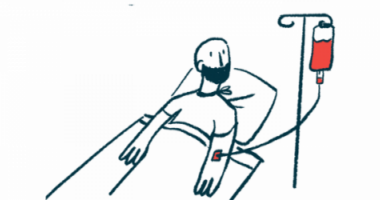MDA 2023: Nexviazyme for nearly 3 years shows benefits in LOPD trial
New Phase 3 trial data show therapy improves walking, breathing

Nearly three years of treatment with Nexviazyme (avalglucosidase alfa) led to long-term improvements in walking ability and lung function for people with late-onset Pompe disease (LOPD), according to new data from the Phase 3 clinical trial COMET.
Positive trends and safety outcomes also were seen among patients who switched to Nexviazyme after a year of treatment with Lumizyme (alglucosidase alfa).
“Week 145 [trial] results show sustained treatment effect and continued benefit with [Nexviazyme] … and stabilization of treatment effect after switching from [Lumizyme to Nexviazyme], supporting the long-term maintenance of clinically meaningful outcomes with [Nexviazyme],” the researchers wrote.
The data were presented at the Muscular Dystrophy Association’s MDA Clinical & Scientific Conference, in the presentation, “Efficacy and safety of avalglucosidase alfa in participants with late-onset Pompe disease after 145 weeks of treatment during the COMET trial.” The work was funded by Sanofi, which markets both Nexviazyme and Lumizyme.
Evaluating the impact of long-term treatment
Pompe disease is caused by mutations that lead to the reduced function or absence of the enzyme acid alpha-glucosidase. Lumizyme and Nexviazyme are both enzyme replacement therapies (ERTs) that aim to deliver a healthy version of this enzyme to the body’s cells.
Lumizyme was the first ERT to be approved for Pompe disease — winning approval in the U.S. in 2010 — while Nexviazyme, approved in 2021, is a second-generation therapy designed to get more of the enzyme to the body’s cells.
“The idea here was, could efficacy be improved by modifying the enzyme” to get into cells better, said Volker Straub, MD, PhD, of Newcastle University, who presented the findings at the MDA conference.
The Phase 3 COMET clinical trial (NCT02782741) enrolled 100 people with LOPD, ages 3 and older, who had not previously been treated with an ERT. For the first part of the trial, which lasted about a year, participants were randomly assigned to treatment with either Lumizyme or Nexviazyme.
The results from this part, first shared in 2020, showed that measures of lung function and walking ability trended toward better scores in patients given Nexviazyme, though differences between the therapies generally were not statistically significant.
After the initial part of the trial, patients had the option to continue into an extended treatment phase, in which all were treated with Nexviazyme. This phase included all 51 patients who had been on Nexviazyme in the original study — referred to as the Nexviazyme-arm — and 44 participants who switched from Lumizyme to Nexviazyme upon entering the extension phase. The second group is referred to as the switch-arm.
The findings presented at the MDA conference covered data out to 145 weeks (nearly three years) of total Pompe treatment. Those in the Nexviazyme-arm had been on the therapy for the entirety of this period, while those in the switch-arm had been on Nexviazyme for about two years following the first year on Lumizyme.
During the study, participants were assessed for average forced vital capacity (FVC), a standardized measure of lung function based on how much air someone can forcibly exhale after taking a deep breath.
Average FVC had improved markedly for patients in the Nexviazyme-arm shortly after starting treatment in the original COMET study. By week 145, the average FVC was still higher in this group than it had been at the start of the study.
“Even after 145 weeks, that improvement [in FVC] was maintained from baseline [the start of the study],” Straub said.
For the switch-arm, average FVC values were largely stable in the original study while patients were on Lumizyme.
“The patients that switched didn’t deteriorate further, but actually continue to be stable,” Straub said.
Better walking ability seen in patients on Nexviazyme from the start
The distance participants could walk in six minutes, or 6MWD, a common measure of walking ability and exercise capacity, had increased markedly for patients in the Nexviazyme-arm after starting therapy in the original study. By 145 weeks, the average 6MWD was more than 20 meters (about 65 feet) further for patients in this arm.
For individuals in the switch-arm, six-minute walk distances were generally stable over the course of the trial, with an average improvement of 0.29 meters (nearly a foot) by week 145.
“Functional endurance/improvement, based on the [6MWD], … was maintained from baseline in participants who continued [Nexviazyme] in the extended treatment phase, and stabilized in participants who switched from [Lumizyme] in the initial primary analysis phase,” Straub said.
Other measures of lung and physical functions, as well as biomarker measures, generally showed similar trends. Collectively, the findings suggest that, although the original COMET trial failed to show a significant difference in efficacy between Lumizyme and Nexviazyme, “there seems to be a favorable outcome, particularly in the [6MWD],” for Nexviazyme, Straub said.
“These data support the long-term maintenance of clinically meaningful outcomes with” Nexviazyme, he said.
Week 145 [trial] results show sustained treatment effect and continued benefit with [Nexviazyme] … and stabilization of treatment effect after switching from [Lumizyme to Nexviazyme], supporting the long-term maintenance of clinically meaningful outcomes with [Nexviazyme].
Long-term data from the study were generally consistent with earlier findings in terms of Neviazyme’s safety profile, and importantly, findings did not suggest any noteworthy concerns among patients who switched from Lumizyme to Nexviazyme in the study.
“There were of course some concerns that if you switch patients from one enzyme to another enzyme, might there be immune responses. Fortunately, those weren’t really seen … if you switch to [Nexviazyme] from [Lumizyme], there weren’t any strong reactions,” Straub said.
“Overall,” he said, “the safety profile was actually very good, and even switching from one to the other didn’t show any increase in adverse events.”
Straub noted that the COMET extension study is still ongoing to continue collecting long-term outcomes for these patients. He also said that, now Nexviazyme is commercially available, it will be important to conduct studies to assess the therapy’s efficacy in real-world settings.








